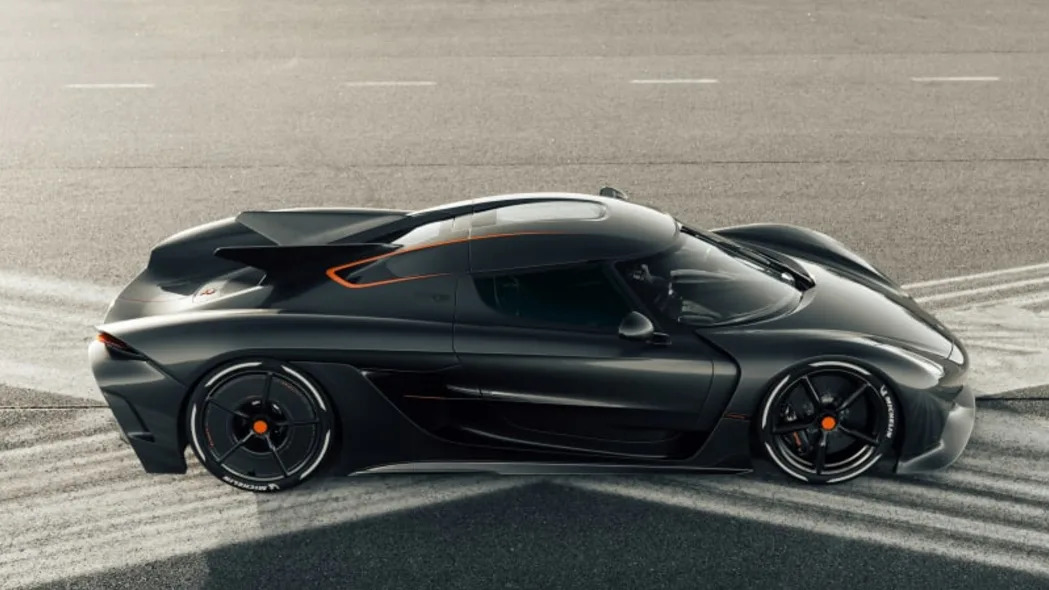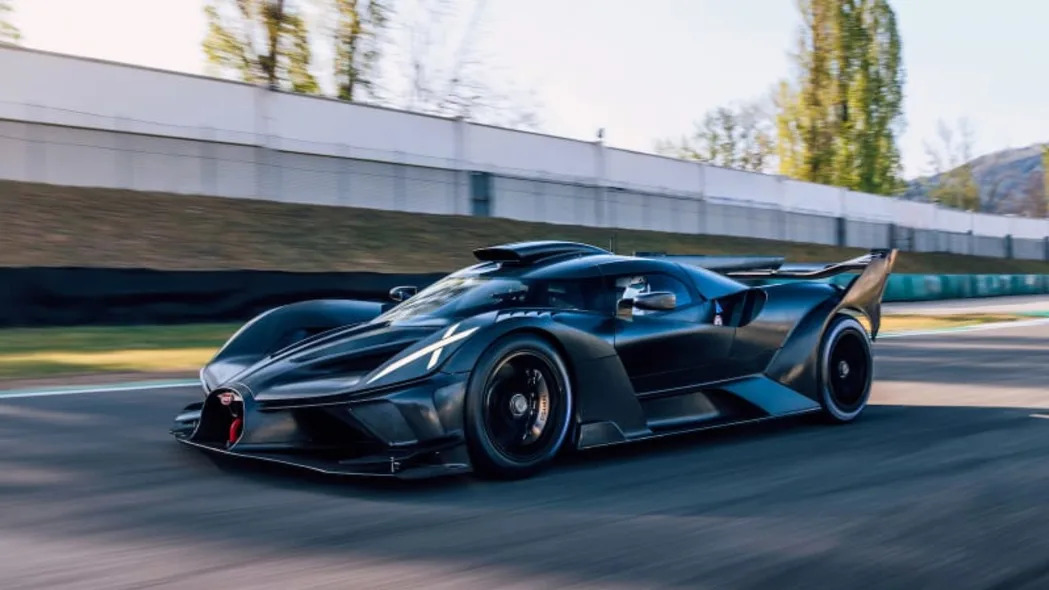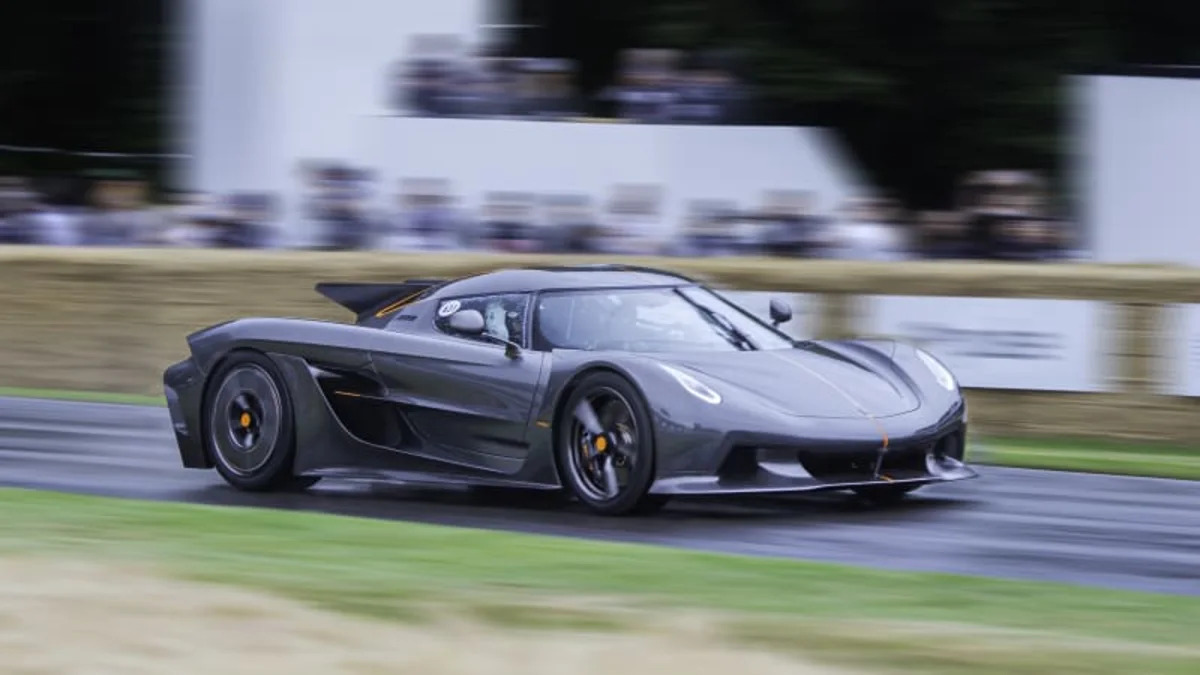There was a time when reaching 200 miles per hour in a car seemed basically impossible. But that didn't last long, and once that threshold was crossed, the automotive world immediately began eying the next triple-digit benchmark. It may have taken a little while, but the 300-mph line has been crossed, and some cars have moved well past that seemingly insane speed number. While some of these speeds have been achieved in simulations (including the fastest car listed below), there's little doubt that a driver with nerves of steel and a heavy right foot could indeed push several automobiles up to 300 miles per hour and beyond.
Interestingly, it’s not just one car or automaker in the 300-mph club, as a large handful of models have earned a place on the leaderboard.
The fastest car in the world is: Koenigsegg Jesko Absolut (330 MPH)

That title goes to the Koenigsegg Jesko Absolut, which recorded a staggering 330 mph top speed earlier in 2023. The car’s twin-turbocharged 5.0-liter V8 lays down 1,600 horsepower and 1,106 pound-feet of torque, which plays a significant role in delivering that speed, but Koenigsegg’s engineers have given the car a lot more than mind-blowing power.
The Jesko Absolut has a super-slippery 0.278 drag coefficient and a nine-speed transmission that shifts so quickly it’s almost imperceptible. Koenigsegg calls it a Light Speed Transmission (LST), saying its shifts happen at almost light speed. While that might be a slight exaggeration, the gearbox is impressive, bringing several wet multi-disc clutches and a super lightweight construction.
As Koenigsegg says, "the Jesko Absolut is destined to achieve higher, more extraordinary speeds than any Koenigsegg or any other fully homologated car before it."
How expensive is the Koenigsegg Jesko Absolut?
If you were reading that and wondering how much the fastest car in the world costs, the price tag is just another dizzying number on the Jesko Absolut's spec sheet. All 125 Absolut cars offered sold out at a price of almost $3 million. Of course, being able to afford the Koenigsegg is just the first step in realizing its full potential. There are very few places on the map that can support a 300-plus-mph speed run, and the locations that do are not conveniently located. That said, it’s likely that many people who shelled out the cash for a Jesko Absolut will be happy with the bragging rights instead of using the speed.
So, the Jesko Absolut holds the speed crown and does so with more than a few miles per hour to spare, but the other cars in the 300-mph club are nearly as impressive.
Other cars that drive faster than 300 mph

The Bugatti Bolide sees 1,847 horsepower and 1,365 pound-feet of torque from a quad-turbo 8.0-liter W16. Its top speed lands at 311 mph, and its styling is just as wild and exaggerated.
However, unlike the Koenigsegg, the Bugatti is a track-only affair. Though it shares an engine and some of its underlying structure with the road-legal Chiron, Bugatti opted to keep the Bolide limited to track duty. While that’s a bummer, especially at the roughly $4.4 million price tag, not having to build a car to meet road car regulations gave Bugatti the freedom to create a brutal car with speed that defies logic. The Bolide is also far more exclusive than the Koenigsegg, as Bugatti produced just 40 of the extreme cars.
The car’s suspension is far stiffer than the Chiron’s, and the car rides on Michelin slicks. It utilizes a revised carbon monocoque and is built using an array of 3D-printed parts. Without the need to worry about curbs, speed bumps, and pedestrians, Bugatti could go wild with aerodynamics and bodywork, resulting in a car that looks like it could cut you.
What goes into creating a car that can go faster than 300 mph?
The Jesko Absolut and Bolide make reaching 300-plus mph sound easy, which you’d expect for their multiple-seven-digit price tags, but there’s a lot that goes into hitting their mind-blowing top speeds. Beyond the fact that it takes miles of glassy-smooth tarmac, the cars have to be exceptionally aerodynamic and be able to consume gobs of air, and fuel consumption at those speeds is immense. Engineers have to shape a car that easily slices through the air while also creating tremendous downforce to keep it on the ground.
Adding thousands of pounds of downforce stresses almost every part of the car, especially the suspension and tires. The dampers have to be able to support the temporarily heavier car while also keeping the tires in contact with the tarmac. At 300 mph, even subtle imperfections in the road surface come faster and much harder, so the car has to be able to cope.
Tires take a particularly brutal beating during the top-speed runs, as their sidewalls get compressed with all the downforce. They’re also subjected to extreme temperatures due to the friction that comes from rubber clawing against the pavement at 300 mph. At that speed, the tires rotate thousands of times per minute, so they must also be sturdy enough to hold their shape through the harsh rotational forces. Finally, high speeds do funny things with the weights of vehicle components, such as the tire pressure monitoring sensors, which can weigh several times their normal amount when rotating at 300 mph and cause wheel imbalances and other issues.
What about the previously fastest cars from Ferrari and Porsche?

While we’re now talking about cars reaching speeds in excess of 300 mph, the first car to cross 200 mph did so more than 50 years ago. The 1969 Dodge Charger Daytona hit 200 mph in March 1970 at Talladega in Alabama. That’s right, the first car to 200 wasn’t wearing an Italian name on its nose, though many of the most well-known cars in the 200 club do. That said, the Charger Daytona, like the Bugatti Bolide today, was not street-legal, and the first road-going car to hit the benchmark was a Ferrari.
Several years after the Dodge’s record-setting run, the Ferrari F40 (below left) reached 200 mph as the first production car with the record. Its twin-turbocharged 2.9-liter V8 cranked out 471 horsepower when new, giving it a 0-60 mph time of 3.8 seconds and a top speed of 201 mph. Interestingly, the most impressive Porsche at the time, the 959 (below right), fell just short of the F40’s speed, reaching “just” 197 mph.
Electric power could change everything
As the automotive world moves toward full electrification, there are questions about EVs’ top speed and battery power, but there are at least five models on sale today with a 200-plus mph top speed. The slick Lucid Air Sapphire offers a 200-mph top speed and a 0-60 time of under 2 seconds. It tied the Tesla Model S Plaid’s top speed but did 0-60 quicker, as the Tesla takes 2.1 seconds to do the deed. The Lotus Evija also promises a 200-mph top speed, but the top two cars are helping move the EV performance needle close to the extreme numbers seen from today’s fastest gas cars. The Pininfarina Battista offers a 217-mph top speed and a crazy 1.8-second 0-60 time, and at the tippy-top of the performance hill is the Rimac Nevera, which offers a 258-mph top speed and a 1.9-second 0-60 mph time.




Sign in to post
Please sign in to leave a comment.
Continue